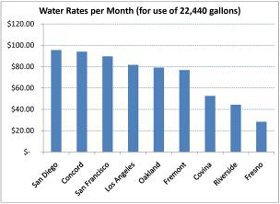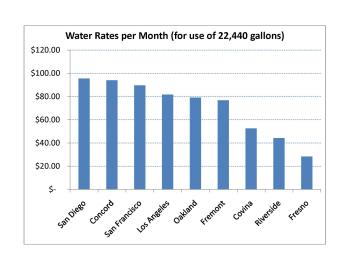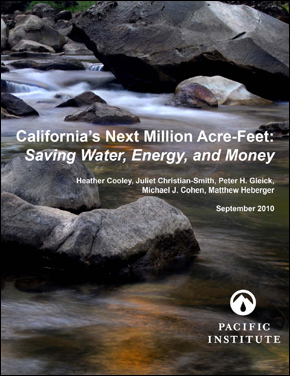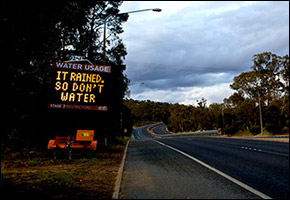Peter Gleick: Smart Water Meters, Dumb Meters, No Meters
How is it possible that a place like California, with such a long and painful history of water problems, remains so far behind the curve of smart water management? How is it really possible that things considered basic, fundamental, taken-for-granted in other places are still missing here? And are water managers and users so insular that they really think they’re doing a good job with water?
That’s a rhetorical question: California is not ahead of the curve in anything “water.” It is dealing with 21st century water problems with 20th century (or is it 19th century) water policy and politics. Some remarkable, innovative efforts are underway, but they remain the exception, not the rule.
To what do I refer? Well, it could be the complete lack of comprehensive groundwater monitoring and management — a fact that stuns my colleagues overseas (and even in other states, and even a remarkably high-ranking official in state government here). It could be the inability to figure out how to put in place permanent, comprehensive water efficiency programs. It could be the archaic agricultural water policies. It could be the inability to properly develop desalination in a way the both provides safe, reliable water but also protects the public interest with environmental protection, transparency, and financial rationality.
But no. This time I mean water meters. Every single water user — residential, commercial, industrial, and agricultural — should have an accurate water meter. And every single user should pay for each gallon of water use, preferably with the price rising with the volume. Again, the fact that this is not the case stuns my water colleagues from other places. And it should. It is an outrage in a place where water is scarce, contested, and still used so wastefully that water use should not be accurately measured and charged.
But of course it isn’t. The people without meters, or people with old “dumb” meters unable to be read remotely or provide detailed information to users, would be at risk of paying more (some would pay less, but some would certainly pay more). People without meters can use, and waste, as much water as they want and no one takes them to task. It is the tragedy of the commons, writ large. And somehow, these self-interested people have been able to influence politicians against taking action to the detriment of the rest of the state, the environment, and all other water users.
Water Numbers: To date, Sacramento still has meters in only 25 percent of its houses and has no intention to meter everyone in a reasonable time period. And they’ve made ridiculous arguments that it would cost too much to put meters in. The Sacramento City Council has authorized a first phase to put in 1,735 meters for $20 million. Explain, then, how come the City of Ottawa will spend $25 million to install 190,000 smart meters? In the arid San Joaquin Valley, south of Sacramento, more than half of all residents are not metered. Fresno, the region’s largest city, charges single-family households a flat rate, regardless of how much water they use. And what do you know? Fresno’s water rates are among the lowest, and their water use among the highest, of anyone’s in California. Average Fresno residential use is 290 gallons per person per day. The state average is 135. For the same amount of water (22,440 gallons, more than enough for a family of four for a month) City of Fresno customers pay, on average, a monthly water rate of only $28.33, compared with San Francisco’s $89.57 and San Diego’s $95.48 (see the figure below). At least Fresno is beginning to slowly add meters.
In some cities, the problem is worst for multi-family homes or apartments, which often have a single meter serving many families. San Diego is beginning to tackle this problem by requiring developers of new multi-family homes to install water meters for each unit. The San Diego City Council has approved a cutting edge water sub-metering ordinance for all new apartment buildings and condos. Councilmember Marti Emerald wrote and promoted this ordinance. This is a big deal: multifamily homes account for 44 percent of the housing units in San Diego and over 1.2 million new residents are expected in San Diego by 2050, according to the SD Union-Tribune, 80% of them multifamily units. Studies show that renters will cut their water use by 15 percent to 39 percent if they pay explicitly for their water use, rather than having their utility costs folded into their overall monthly rent.

Even better, there is a whole new generation of “smart” water meters coming. These can be read remotely, saving millions in door-to-door readers. Smart meters permit more sophisticated pricing structures. And they can provide users real time and effective information on how to save water and money — identifying leaks and providing feedback on water-intensive activities. Toronto Hydro is installing smart water meters and expects to save $33 million on meter readers and collect as much as $24 million that it loses from inaccurate billing from the old “dumb” meters.
It is long past time for a statewide requirement (hey, how about a nationwide requirement?) that all water users have meters installed, quickly, and that water use be charged by volume. In Sacramento, legislation introduced by Assemblyman Paul Fong may tackle part of this. Fong’s measure, AB 1975, would require multifamily complexes permitted after Jan. 1, 2012 to install meters for each unit as a condition of water service. Owners would be required to charge tenants based on the volume of water they use. This is an excellent start but more is needed.
Peter Gleick
Previous posts can be found here.











Comments are closed.